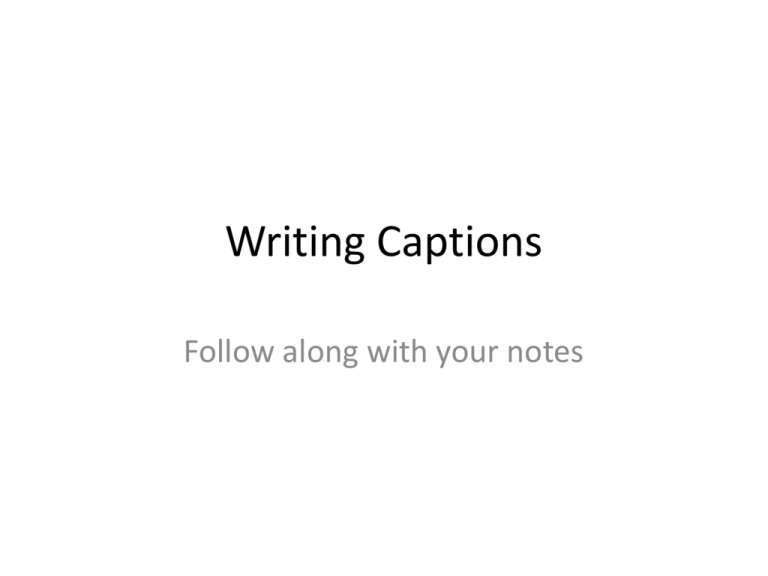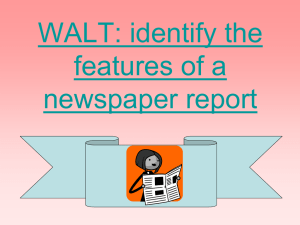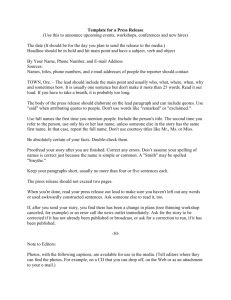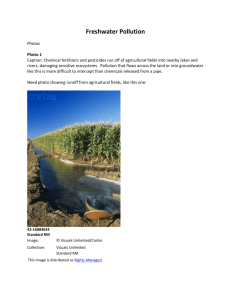Writing Captions
advertisement

Writing Captions Follow along with your notes The first sentence • The first sentence of the caption describes what the photo shows, in the present tense, and states where and when the photo was made. • Should begin with introductory phrase • First 2-5 words will be the caption lead-in (aka ROCKET) ; these words grab reader’s attention & link the photo with the rest of the caption • Identify the people and action of the photo • Avoid stating the obvious (“looking into the camera…” • Avoid starting the sentence with a person’s name • If there are more than 7; identify main participants (always left to right) The second and any remaining • The second sentence of the caption gives background on the news event or describes why the photo is significant. • Past tense • Provide background info; consider action before the photo and reaction after • Interview the people in the photo to grain perspective • Use colorful and active VERBS! Additional Guidelines • Vary caption lead-ins • Don’t use joke captions- ethical/legal probs! • Avoid editorializing; allow action and background info in photo to tell the story- meaning NO OPINIONS! • Be consistent/ follow standards • Always include a photo credit (the photo-by should be in italics) • Use quotes to add personal touch • Font that should be used- sans serif in 8 point size • Use an INDENT when there is little space on layout but you still want to identify people in the photo Types • Indent Caption- used when there is little space on a layout but you still want to identify the people in the photo. • Summary- Highlights the most important 5 W’s & H. • Expanded- answer’s the Big 6, provides additional info/ details like background info and quotes. Standard AP Caption The Mississippi River flows through a hole in the Sny Island, Ill., levee, flooding farmland and homes 10 miles south of Quincy, Ill., Sunday, July 25, 1993. About 2,000 people were evacuated from the 44,000 acres that flooded. (AP Photo/Bill Waugh) Bad examples • Example: (bad) HE’S OUT. Chuck jumps and throws toward first. (be specific) • Example: (bad) OUCH! Oxford High bicyclist crashes. (tell something other than the obvious) • Example: (bad) AMY ROSSFIELD gets ready for practice. (continue the story begun by the picture) Good Examples • Example: (good) UP AND OVER. Shortstop Chuck Davidson avoids Dan Gladden’s rolling slide and makes the throw to first to complete the ninth inning double play which sealed Oakland’s 3-2 win over Birkdale Twins in the sub district playoffs. • Example: (good) DOWN AND OUT. Senior cycling team captain Bob Everitt takes it on the chin after cutting the final corner too close in a duel with Mosby High’s Steve Sherrill at the season’s first race. After a trip to the hospital and 10 stitches, Bob went on to win five races for the year and led the team to an overall second place finish in the region. • Example: (good) DAILY ROUTINE. Junior Amy Rossfield prepares for her afternoon practice. “Since I won the state dance competition last year,” she said, “I look forward to practice because I want to win again.” Firefighters extinguish a blaze that began when a woman apparently feel asleep after lighting a candle early Tuesday morning. (AJC) Good Samaritan Ali Robinson, 53, rushed to the aid of an elderly man who fell off a MARTA platform onto the train tracks at the Little Five Points station on Tuesday, October 12, 2010. (AJC) Director Oliver Stone poses for the photographers during a photo-call for the new movie 'Wall Street, Money Never Sleeps' in Berlin, Germany, Tuesday, Oct. 12, 2010. (AP Photo/Michael Sohn) Captivating Captions Activity • Look at chosen picture • Answer as many questions as you can • Conduct research on the picture to figure out who it is (ask the questions as if you could) • Brainstorm lead-ins • Write a draft of your caption • Fill in the Big 6 and Caption draft on sheet provided



